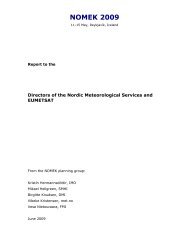International Symposium on Mitigative Measures against Snow ...
International Symposium on Mitigative Measures against Snow ...
International Symposium on Mitigative Measures against Snow ...
You also want an ePaper? Increase the reach of your titles
YUMPU automatically turns print PDFs into web optimized ePapers that Google loves.
<str<strong>on</strong>g>Internati<strong>on</strong>al</str<strong>on</strong>g> <str<strong>on</strong>g>Symposium</str<strong>on</strong>g> <strong>on</strong> <strong>Mitigative</strong> <strong>Measures</strong> <strong>against</strong> <strong>Snow</strong> Avalanches<br />
Egilsstaðir, Iceland, March 11–14, 2008<br />
Figure 6 Compressive force (kN) and moment (kNm) in a post in the Geobrugg nets in<br />
row II in Siglufjörður. Wiggles in the force curve near the beginning and end of the<br />
record are due to differential heating of the post by the sun <strong>on</strong> clear days.<br />
The measured tensi<strong>on</strong> in the upper anchors of the nets appears to be within the design<br />
assumpti<strong>on</strong>s of the Swiss Guidelines (SLF, 1990). The moment load is, however, c<strong>on</strong>siderably<br />
higher than assumed in the guidelines. The guidelines give a design moment load of<br />
<strong>on</strong>ly 5.7 kNm when allowance has been made for the high density of the Icelandic snow. This<br />
is less than <strong>on</strong>e third of the measured maximum moment in Siglufjörður. The guidelines are<br />
based <strong>on</strong> the assumpti<strong>on</strong> that the snow pressure <strong>on</strong> the post is given by the depth averaged<br />
snow pressure <strong>on</strong> the c<strong>on</strong>structi<strong>on</strong> applied over the width and length of the post (this is the<br />
assumpti<strong>on</strong> η =1 in eq. (58) in the guidelines). In practice, the effective width of the post may<br />
be expected to be substantially larger than this because the post will support more snow than<br />
corresp<strong>on</strong>ds to its width.<br />
4. CONCLUSIONS<br />
The pilot experiment in Siglufjörður has provided many less<strong>on</strong>s for design of supporting<br />
structures for Icelandic c<strong>on</strong>diti<strong>on</strong>s after more than a decade of observati<strong>on</strong>s. The main c<strong>on</strong>clusi<strong>on</strong>s<br />
may be summarised as follows.<br />
4.1 <strong>Snow</strong> properties<br />
The gliding of the snow pack al<strong>on</strong>g the slope was found to be low, <strong>on</strong>ly several cm during the<br />
winter. Reference values for snow density during maximum snowpack thickness<br />
(400−450 kg m −3 ) and for spring loading with a higher density (500 kg m −3 ) were determined.<br />
4.2 Loading<br />
Measured loads <strong>on</strong> the structures were in general within the corresp<strong>on</strong>ding design loads of the<br />
Swiss Guidelines from 1990, with the excepti<strong>on</strong> of the moment load <strong>on</strong> net posts which<br />
turned out to be substantially larger than assumed. The maximum loading of the structures<br />
148 Supporting structures under Icelandic c<strong>on</strong>diti<strong>on</strong>s











